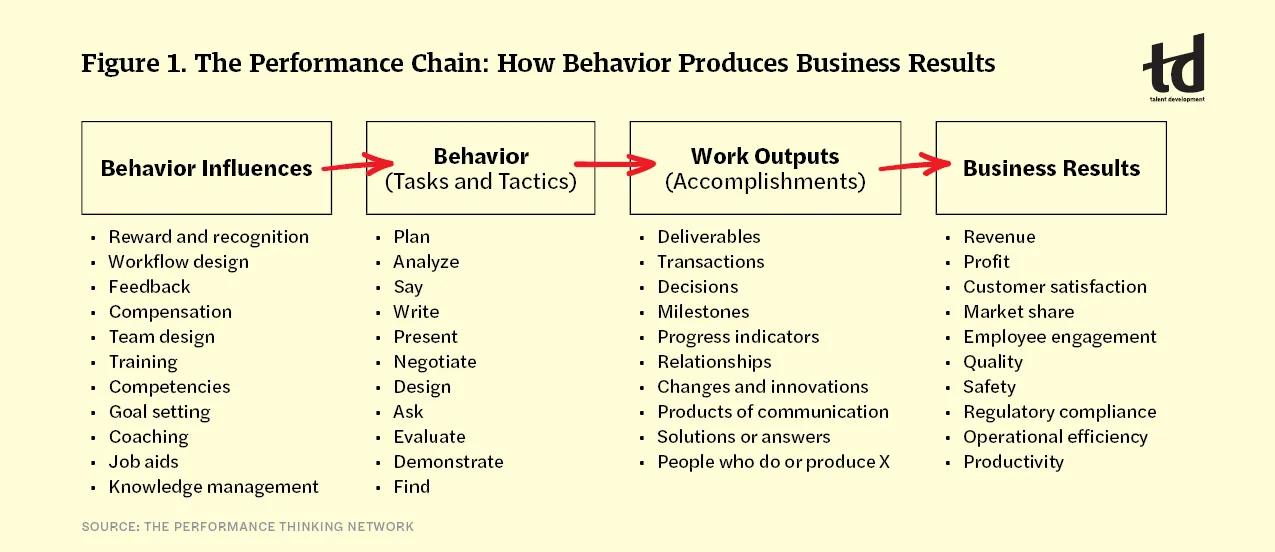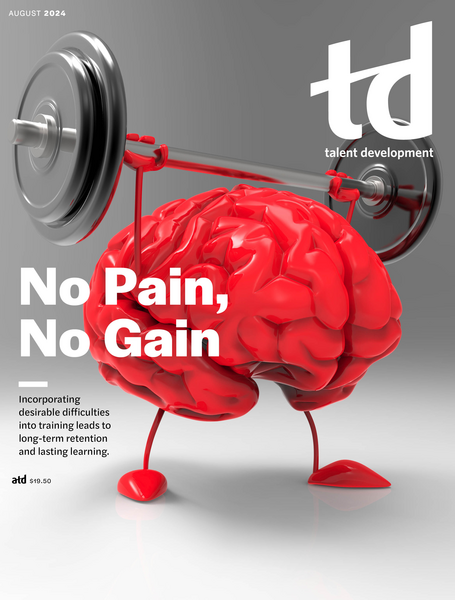TD Magazine Article
The Value in Focusing on Work Outputs
Apply accomplishment-based talent development throughout the employee life cycle.
Thu Aug 01 2024

In his groundbreaking 1978 book, Human Competence, Thomas F. Gilbert encouraged those concerned with human performance in organizations to focus on the valuable accomplishments that people produce with their behavior, not on what he called "costly behavior." Known as the father of human performance improvement (HPI), Gilbert pointed out that by anchoring the analysis and design of performance interventions to accomplishments, talent development professionals, leaders, and managers can "engineer worthy performance."
He calculated the worth of a performance intervention (now described as return on investment) as the value of the accomplishments it enables people to improve or add, divided by the cost to establish and support the necessary behavior to produce those accomplishments. That insight led to a paradigm shift among HPI professionals and ultimately to a reframing of TD as based on accomplishments.
Valuable accomplishments include widgets, plans, relationships, decisions, agreements, and recommendations. To produce a widget or plan, for instance, an employee completes a series of steps (behavior). Similarly, to offer a recommendation, a worker must investigate, meet with others, and complete various fact-finding activities. In each example, the employee's behavior produces valuable accomplishments.
Joe Harless, Gilbert's protégé, extended Gilbert's vision in his Accomplishment Based Curriculum Development (ABCD) methodology, which organizations such as the US Coast Guard, FedEx, Bell South, and Boeing have adopted. ABCD begins by targeting accomplishments that employees will produce, identifies tasks (behavior) they will need to produce those accomplishments, and designs training and nontraining solutions to establish and support the necessary behavior. By identifying the accomplishments managers expect of their staff, instructional designers can focus training on the required behavior to produce those accomplishments.
During the past two decades, a growing community of professionals have extended the application of Harless's approach beyond training to encompass all stages in TD. Accomplishments can guide the process from initial hiring and onboarding through continuous development and decisions about salary, promotions, career paths, and succession planning. At each stage, the valuable accomplishments, or contributions, an employer needs from staff serve as goals and objectives.
Accomplishments as countable nouns
Since Gilbert's original publication of Human Competence, performance consultants and HPI practitioners, among others, have used the term accomplishment in a variety of ways. Some use the term to describe organization-level results such as revenue or profits, while others list accomplishments as completion of procedures (behavior) intended to deliver value. That has created confusion in a field where practitioners often use terms such as outcomes, accomplishments, and results interchangeably.
In its certification and coaching programs, the Performance Thinking Network (my company) adopted the phrase work outputs to emphasize two critical features of accomplishments: A work output is the product of behavior (that is to say, of work), not merely the completion of behavior, and it is a countable thing. That definition distinguishes between behavior and the products of behavior, which may include both tangible and intangible outputs. Work outputs can be concrete, physical things such as widgets, documents, or prototype products. They may also include intangible products of behavior, such as recommendations, decisions, or valuable working relationships.
Accomplishment-based TD defines the elements of human performance in the performance chain model (see Figure 1).
Training and nontraining behavior influences establish or support behavior that produces accomplishments (or work outputs), which are valuable to the extent they contribute to business results.

Performance maps highlight accomplishments
In the field of performance improvement, organizational relationship maps, process maps, and individual performance maps are among the three levels of performance mapping that analyze and improve performance. Organizational relationship maps, pioneered by Geary Rummler, depict the groups, departments, and teams within and outside an organization and list the major outputs or accomplishments they deliver to one another. Such maps are helpful when employers are considering changes in organizational structure or new cross-functional processes.
Most TD professionals have seen or created process maps. While it is conventional to identify the final outputs of processes, many process maps do not list outputs of each step inside the processes, also known as milestones. Listing milestones makes processes easier to measure at each step and easier to diagnose when something goes wrong within processes, so TD can design solutions. Process maps that highlight the accomplishments of each step can clarify context and guide development for employees who execute the processes.
An individual performance map can guide every stage in TD by listing the work outputs that a company expects a person or role to deliver to each internal or external customer. The number of work outputs for a job can vary from fewer than a dozen for a specialized role to several dozen for a senior leader.
With a complete list of a job's expected work outputs, the talent acquisition team can create accomplishment-based behavioral interview questions and performance tests. An onboarding team can manage the process of getting new hires up to speed producing specific accomplishments immediately, in the first week, and into the future, staged over time. Training can target accomplishments that new employees will need to produce or the specific contributions that managers will expect from them on the job. Employers can base decisions about promotion and compensation on the value of new or improved accomplishments that an individual is able to produce over time. And succession planning can address the accomplishments that a newly promoted person in a strategic role must contribute.
By distilling information captured in multiple interviews of successful performers, using individual performance maps, anyone responsible for talent acquisition and development can create lists of accomplishments that are more actionable and measurable than traditional job descriptions. The lists will enable managers and HR professionals to set precise, measurable expectations for individuals and provide actionable feedback based on criteria for "good" instances of the outputs.
While managers often focus on employees' contributions intuitively, TD practitioners can explicitly list the accomplishments that define each job so that everyone involved can refer to those lists. HR professionals, leaders, managers, or coaches can revise or expand jobs by adding and subtracting work outputs according to the needs of the company and the processes that serve it. To address changing priorities, managers can make adjustments in performance expectations for their team members.
Improved job profiles
After the Performance Thinking Network had been creating individual performance maps in organizational performance analyses or when coaching individuals for years, the company recognized that it could expand the maps to form detailed job profiles that support TD. Both managers and their direct reports appreciate individual performance maps for how specific and measurable they are.
With careful choice of language, a one-page performance map with all a job's work outputs can set expectations for an employee, clarifying what each customer expects (see Figure 2). It can provide context for conversations with managers and TD professionals about how each output contributes to the organization's results and for what accomplishments to master for a next job level, a new project, or an expanded role. Each of those aspects contributes to overall employee engagement and satisfaction, with a focus on continuous development.
Create expanded accomplishment-based job profiles by adding criteria that define good instances of each accomplishment (for example, timeliness or quality), listing best practices that top performers use to produce those accomplishments (what Gilbert called "exemplary behavior"), and pointing to key enablers available to support performance (such as goals, documents, tools, recognition, and staffing). Everyone involved can use such profiles to set expectations (including for their own jobs) and provide more useful and actionable feedback than when feedback focuses on behavior, skills, or competencies.
The specificity of well-defined accomplishments makes the approach powerful and practical. What surprises most people who see their entire job as a list of work outputs on a single page is that the description is so actionable and easy to measure objectively:
Did I, or did I not, produce that work output to meet criteria?
How many good outputs did I produce?
Do I need help to improve?
How many outputs have I added to my capability this quarter?
Such questions flow naturally from accomplishment-based job profiles.
![Figure 2. Sample Individual Performance Map for the Head of Talent Acquisition Head of Talent Acquisition [four arrows point away from this central box to each of the following four boxes.] Division/Brand Heads • Newly hired employees (quality talent)
• Internal hires (customer makes decision)
• Annual hiring plan for the brand (Note: We should do this as a process)
• Long lists of candidates
• Short lists of candidates
• Success profiles
• Job briefs (has parts)
• Interview forms HR Business Partners • Action plan for meeting staffing requirements Job Candidates •Job description
• Performance objectives
• Offer Head of Talent (Manager) • Efficiency reports around processes
• Improved documents
• Process designs
• Implementation plans
• Lists of key achievements
• Website designs SOURCE: THE PERFORMANCE THINKING NETWORK](https://assets.td.org/transform/8ac0ba88-c900-4e95-96ae-c12e7a484b68/Feature3_Chart2)
Accomplishments across the talent life cycle
The following stages are typical ways to describe the process of TD in an organization.
Initial hiring. Identifying accomplishments that a hiring manager expects of a job sets a foundation for behavioral interviewing questions and performance tests focused on key contributions that the job must deliver.
Lists of work outputs help interviewers set expectations with candidates during the hiring process. They can ask questions such as "Have you ever had to create a strategic plan for your team? How did you go about that?" They can design assessments asking candidates to critique or improve a proposal, plan, or budget; diagnose issues with a key working relationship (for example, with customers or direct reports); or adjust settings on a standard piece of equipment. Focusing the hiring process on expected accomplishments of the job is more efficient and effective than discussing or assessing competencies or other abstract descriptions of performance.
Onboarding. In the first weeks or months of a new job, there are typically work outputs that new hires must deliver immediately (for example, customer service representatives must know answers to common questions and how to change account information), and others that can wait longer (such as responses to complex problems and solutions to matters that come up less frequently). Onboarding with training, supervision, and other forms of support can proceed with development and mastery of those accomplishments, staged according to urgency and priority.
Job preparation. Whether through training or other means (such as reading, shadowing expert performers, or learning in the flow of work), organizations enable newly hired staff to gain expertise for delivering specific accomplishments. With a focus on the valuable products of behavior, criteria-referenced training and development strategies can prepare people to make the contributions the company expects of them.
Program objectives such as "After completing this program, you will be able to contribute the following accomplishments to the organization" are more likely to engage employees in their own development because the immediate connection to job performance is clear. Staff will know what they will deliver—not just how—and everyone involved can be more creative and collaborative supporting new capabilities, not merely through training.
Ongoing coaching. Managers can learn to coach their direct reports with a focus on the accomplishments their employees need to contribute. Coaching conversations can target specific work outputs and explore how they contribute to the organization's desired results. In a regular cadence of check-ins, managers and their team members can collaborate on agreed-upon action steps to improve productivity and engagement. Accomplishment-based coaching can guide and help individuals advance up career ladders or prepare for changes in job requirements.
Performance reviews, promotion, and salary negotiation. Sales performance is often easier to measure and compensate than other types of performance because sales milestones are work outputs (for example, qualified prospects, requests for proposals, and appointments with decision makers) linked to business results that include revenue and market share. That is not always true of other jobs, especially when companies define those jobs by skills, knowledge, or competencies. With job profiles that list valuable accomplishments that a manager expects from their employees, and linking those work outputs to business results, staff can experience a greater sense of their value to the organization, and the company can make more value-based compensation decisions.
Succession planning. Companies can plan the succession process based on accomplishments the successor will need to contribute. Job profiles can list key customers and contributions of the executive or other key player who is departing, set the stage for identifying relevant contributions that the potential successor has produced in the past, and design a process to enable them to produce all key accomplishments of the role to which they are succeeding. Accomplishments make the process more measurable and criteria-referenced as individuals learn to produce specific work outputs required for the job rather than exhibit particular behavior or competencies.
Advantages and benefits
If you currently use a competency- or skills-based approach, a shift to accomplishment-based TD offers important benefits.
Performance expectations will be more concrete and measurable. Standards or criteria for good instances of an accomplishment (for example, a budget, mechanical assembly, decision, or relationship), make it easier to set expectations, provide feedback, solve errors, assess capabilities, review performance, and develop talent than focusing on skills separated from accomplishments or trying to rate people on competencies.
Managers can connect individuals to success for the whole enterprise. Employees appreciate knowing how their day-to-day work contributes to the company's success. It is generally more straightforward for managers to say, for a given work output, how it will contribute up to one or more organizational results, than to convince staff of how skills, knowledge, or competencies contribute to specific results. Leaders who highlight the connection can help to improve employee engagement.
Development can more easily incorporate training and nontraining elements. A focus on skills, knowledge, or competencies usually emphasizes learning, often via training. When the goal is to help people produce valuable accomplishments, solutions can be as simple as clearer expectations with more frequent feedback, a job aid and coaching, or improved tools or workflow. An accomplishment-based approach welcomes all types of behavior influences, with an emphasis on ROI.
Accomplishments equal value. Gilbert's emphasis on accomplishments highlights the value people contribute (versus the cost of behavior) and can become a cultural value statement such as "We focus on our internal and external customers, and we continuously improve the value we deliver to them." Emphasizing the value people deliver with their accomplishments can be a powerful strategy for TD, at every level, from the CEO to the frontline employee.

